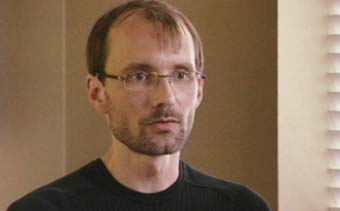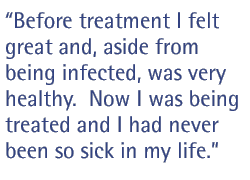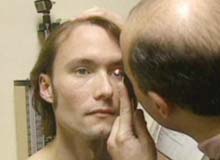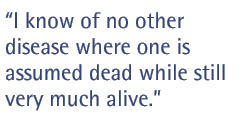
"Serendipity" picked William W. Dodge IV ("Dodge") to become patient no. 9 in the study of the first successful triple cocktail, pioneered by Dr. David Ho and others at the Aaron Diamond AIDS Research Center in 1996. Although the treatment developed in that study has saved the lives of millions of people around the world, it certainly wasn't easy to be a guinea pig. In this powerful personal essay from April 2006, Dodge writes about why he chose to volunteer for the study; the trauma his body has been through; his decision to stop treatment to see if the virus would return; his abandonment by a father who couldn't stand to "watch me die"; and his feelings of trepidation about leaving the study that has kept him healthy for so long.
I became infected with HIV in the late fall of 1995. Seroconversion, the "flu" one experiences after infection, occurred on my 30th birthday.
I was living in New York at the time, and I was very much in love with an Australian fashion photographer who was the source of my infection. He was very open about his positive status, and I entered into the relationship consensually, with no naïveté. I am a Southerner who was raised in North Carolina, but I came of age in the 1980s, when AIDS was a new, unknown entity and quite terrifying. In 1987 I had moved to Paris, where I lived for a number of years and watched a number of friends die, so I was very familiar with AIDS.
Because of that familiarity, I was never cavalier. I was adamant about condoms and safer sex practices, and never deviated from that. My mantra was, assume everyone is positive and act accordingly.
The question I am most asked is why I would have become involved with someone I knew to be HIV positive. Although I find the question to be highly insulting, the answer is quite simple: Knowing is better than not knowing. Someone can only know if they are positive; they can almost never be sure of being negative, because it can take months for someone to test positive after they are infected.

Of course I entered into the relationship with a certain amount of trepidation. I knew he was positive. We did everything we knew to protect me from his virus. Unfortunately, 99.9 percent is not the same as 100 percent. Although I really should never have become infected, I did. At the time, doctors generally believed that oral sex without an exchange of fluids was relatively safe. I was probably made more susceptible at the time by a severe case of bronchitis resulting in an inflamed esophagus.
I know enough to know that one can do everything right and still fail. At no point have I regretted having been in this relationship. True, my life would have been very different and certainly easier had I remained HIV negative, but I honestly believe that had I not known this man, I would not have acquired the skills that have allowed me to get to where I am today.
Keep in mind that in 1995, there were no successful treatments for HIV. HIV was equated with AIDS, which equaled death. My friend did not accept that. He insisted that he would live. He would fight to live with whatever tools he could find, and no one would stop him. He used to say to me: "Do you know what is the best thing about being HIV positive? It is positive, and if something is positive, it has to be good." He was with me and watched as I went through seroconversion illness. He recognized it because he remembered his own. It was he who forced me to get tested. I argued with him because I saw no point to it. There were no treatments, and I really did not want to know that I was going to die. He insisted. He said, "Knowing is better than not knowing, because if you know, you can fight." I wondered how I was supposed to fight if there was no treatment. He explained that it was the act of fighting that would keep me alive.
Normally I would have been tested anonymously at a clinic, but I knew in my gut that the results were going to be positive and I would need to talk to someone whom I knew and trusted. I decided to have my private physician, the one who had treated me for bronchitis, run the test. Waiting days for the result was stressful, but having him lead me into his office instead of the exam room was horrifying. The test had come back positive. The doctor knew about my history with the photographer, and he said that my "flu" really did appear to be seroconversion illness. He wanted to run more tests to confirm the positive result, but also to try to pinpoint when my infection took place. He said not to panic. He said he had some phone calls to make.
I went back a week later. He confirmed my positive result, but he also said that my blood work had confirmed that my infection was recent. At this point, he gave me a slip of paper with an address written on it and told me to leave his office and go directly to this address. There I would find a Dr. Martin Markowitz, who was expecting me. I had no idea who this Markowitz fellow was or why I was supposed to see him. I did as I was instructed and took a cab to the address. I was supposed to go to the seventh floor of the Public Health Building. It was a very shabby building. I went through security and onto the seventh floor. It was a shock. It was stunning with its stainless steel, birch and marble, with windows that looked into beautifully equipped labs. It looked like a movie.

As I got off the elevator, a man approached me, introduced himself as Marty Markowitz, and asked if I was Dodge. He led me into a boardroom with its walls lined with books and [a] huge marble conference table. He asked for my test results. He seemed pleased and asked if he could draw my blood. I think it was at this point I looked at him and asked, "What is this place, and why am I here?" He told me I was in a place called the Aaron Diamond AIDS Research Center (ADARC). My reason for being there was that because of my very recent infection, I appeared to be a good candidate for an experiment that might lead to a possible cure for HIV. I was incredulous. I thought there were no treatments. That was when he told me about an experimental drug that showed tremendous promise. It was called a protease inhibitor.
On Feb. 1, 1996, I checked into the Rockefeller University Hospital to begin treatment. I was patient no. 9 of a protocol labeled MMA-160, one of the protocols that would create a frenzy at the International AIDS Conference in Vancouver the following summer. I was beginning triple combination therapy, what the scientists referred to as HAART (highly active antiretroviral therapy) but the media dubbed "the cocktail."
Those early drugs were quite a cocktail: ritonavir (ABT-538), zidovudine (AZT) and lamivudine (3TC). I took a total of 20 pills a day, following a strict dosing regimen. Two capsules of AZT had to be taken three times a day. One tablet of 3TC had to be taken twice a day. The remaining 12 capsules of ritonavir, the protease inhibitor, were to be taken in doses of six, twice a day, on a completely empty stomach. I could not eat two hours prior to taking my medication or one hour after. The time schedule was crucial, and absolute compliance was required.
I had a bad relationship with ritonavir. The capsules were huge, the largest pill I had ever taken, and they were made of wax. The drug was actually a liquid and could not exist in pill form, but because of its especially foul taste it could not be administered as a liquid. Wax capsules were the only viable solution, and they had to be kept refrigerated. The prototypes that I took were not sealed and had a tendency to leak. If my throat closed on one, which happened often, it would break open and burn.
There were side effects, too. The ritonavir caused extreme nausea, occasional vomiting and constant diarrhea. Either the AZT, or maybe the 3TC, made my face and hands so numb that reading a newspaper was an ordeal because I could not feel the paper in order to turn a page. All of this was accompanied by a lack of stamina that made a flight of stairs an exhausting experience. Before treatment I felt great and, aside from being infected, was very healthy. Now I was being treated, and I had never been so sick in my life.
Being "undetectable" means that the amount of the virus in blood is too low to be measured. It does not mean that the virus is not present, but it is a very good thing. On day 10 of the treatment, when I was checking out of the hospital, I asked Markowitz when he thought I would become undetectable. He smiled and said, "You already are." I had become undetectable on day five. The drugs were making me very sick, but I had a weapon with which I could fight. Serendipity had chosen me for this battle, and I was determined to rise to the occasion. I would give the researchers whatever they might want.

As time went on, the medications became more tolerable. It wasn't that the side effects were going away, although they probably lessened in intensity, but that they were simply becoming part of my reality. I was beginning to forget what I felt like prior to starting treatment.
In July, the preliminary results of the study were released at the AIDS Conference in Vancouver. A media firestorm ensued, and the press wanted a face to go along with their news reports. The Aaron Diamond Center is extremely protective of its patients and their privacy, but I told them I wanted to be public. I was willing to talk to the media, even though I knew that it would embarrass my family and make my life awkward. But I believed very strongly that it was the right thing to do. These new medications were becoming available to the public. If the public knew about them, lives could be saved.
The publicity had an unforeseen impact on my life. Letting go of the secrets made my life much easier and healthier. But something else happened. Guys would approach me on the streets of Manhattan and tell me that they had seen me on television, and because of seeing me they had gotten tested. Many had tested positive and were scared; they wanted to talk. I would stop whatever I was doing for that conversation. These guys were the reason I was involved in the research. I realized why they chose me: They felt they somehow knew me, but they also knew I did not know them, so their secret was safe. I also represented a semblance of hope.
Never during these conversations would I ever promote the cocktail. I believed very strongly that that was an individual decision one should only make with the advice of a doctor. But I would force them to make one decision: I would insist that they choose whether they were going to live or die. I would instruct them to make that choice with the core of their being. "If you consciously choose to live, you will be able to summon whatever strength it takes to survive, and you will live," I told them. "If, however, you choose death, no one can save you." I was still drawing off that key lesson I had learned from the photographer and was passing it on.
As the research evolved, so did its need for data. All procedures were voluntary, and I volunteered for all of them. In addition to blood, I gave semen, spinal fluid, lymph nodes from my neck, tissue cut from my tonsils (on three occasions) and lymph tissue from my colon. The colon biopsy I hated the most, but I ended up doing it twice. Sixty snippets were taken the first time and 45 the second. All of this tissue collecting was a hunt for the virus. At this point, my blood had been undetectable for quite some time, but the question remained as to whether reservoirs of the virus could be found elsewhere.
The primary goal of the study was to see how well the virus could be suppressed in the host. The ultimate goal was to find out what would happen if one were to be taken off of treatment. The hope was that the body would continue to suppress the virus on its own without the aid of medication. The only way to discover if this would happen was to attempt it. In December 1998, almost three years after I started the experiment, it was time to try. My participation in the withdrawal of treatment was entirely voluntary, but of course I volunteered. The result was a disappointment. The virus came back quickly. I stayed off of medication for almost two years, with Markowitz following me closely.
In September of 2000, it was time to try again. I started a new protocol with newer, more powerful drugs. This time I have been undetectable for five and a half years. I am still with Markowitz and ADARC. I am on my third cocktail. I keep trying new drugs not because of drug resistance -- I have never become resistant -- but because ADARC can learn from the newer drugs. I think the reason I have never developed resistance is because I have always been super compliant. I take the medication according to schedule as if my life depended on it. My life does depend on it. But more importantly, I take the medication according to schedule because the research depends on it. I would do nothing to compromise the research.
Recently I turned 40, which means I have been HIV positive for more than 10 years. I have passed what I once feared to be my expiration date. My involvement with the research is coming to an end, because there really is not much more that science can learn from me. I am sad about leaving: Being part of this research is how I have defined myself for a decade. But I also know it is time. I am currently trying to figure out my own future. The future is still a difficult concept for me. Intellectually I can understand that it is very possible for me to have a long life, but my heart is still doubtful. It is ironic that someone who is so insistent on living would have this struggle within himself.
The battle is constant. Society reinforces the notion that HIV is the same as AIDS, and AIDS is death. The message is usually subtle. Sometimes it is a friend expressing compassion by explaining how he will take care of me when I become ill, as if falling ill with AIDS is a foregone conclusion. Sometimes the message is overt. My own father will have nothing to do with me because he cannot bear to watch me die. He has gone as far as to will his estate to a prep school, as a memorial to his only son. I know of no other disease where one is assumed dead while still very much alive. I have fought so hard to change the reality of HIV, but its stigma remains.

